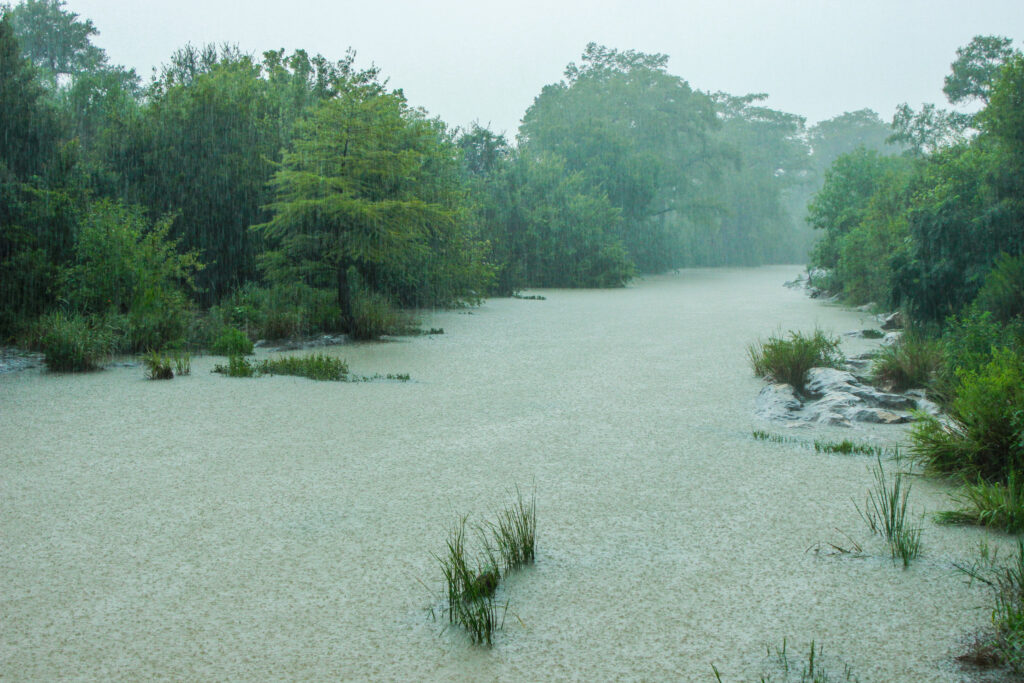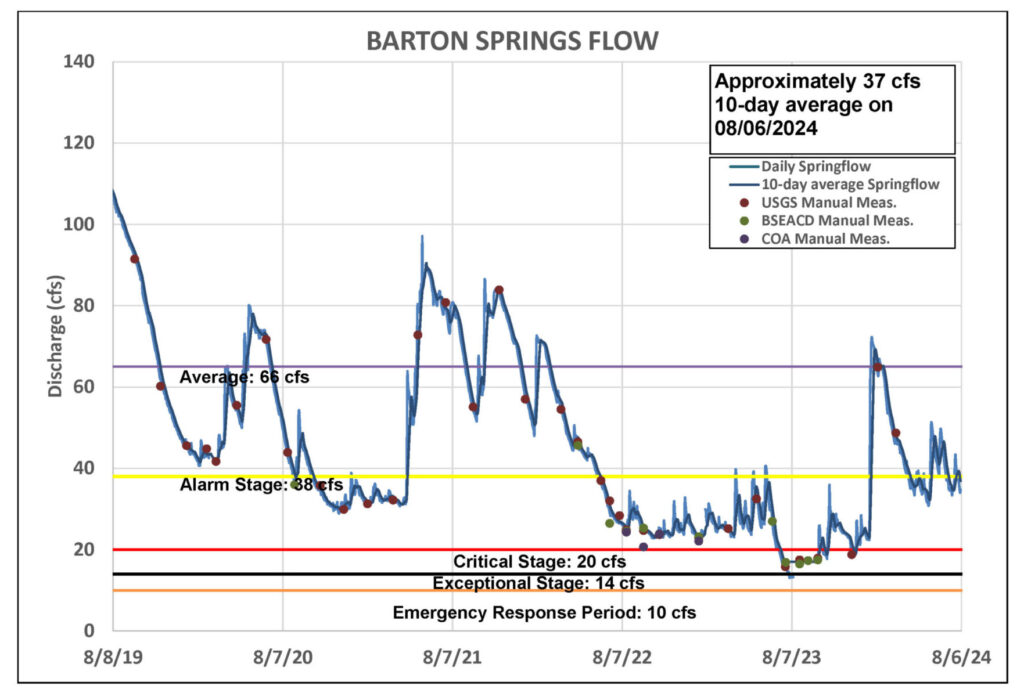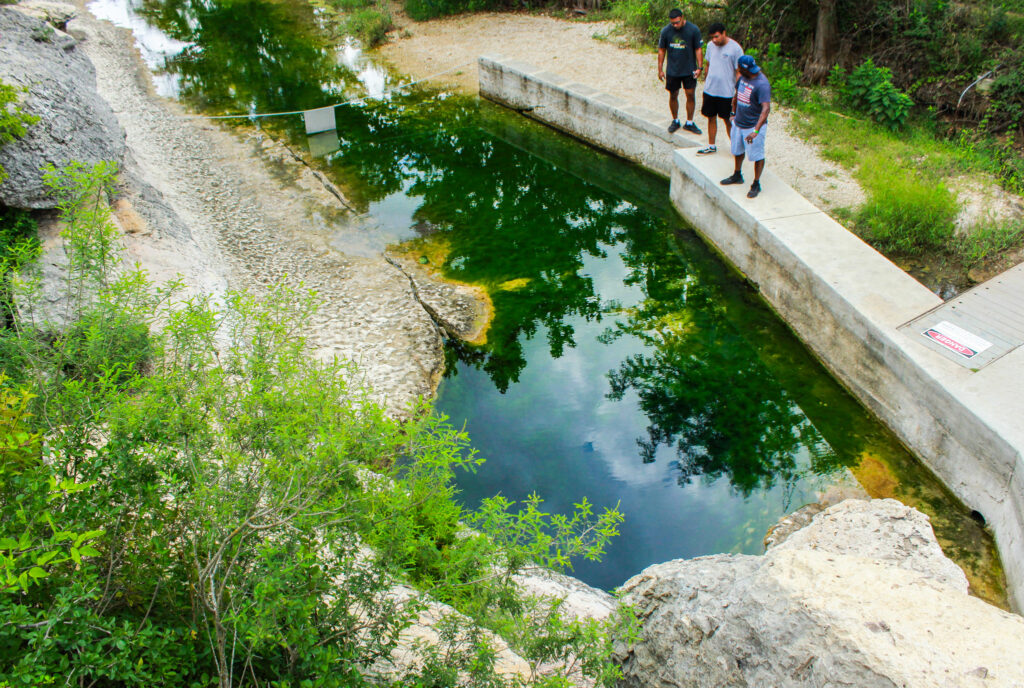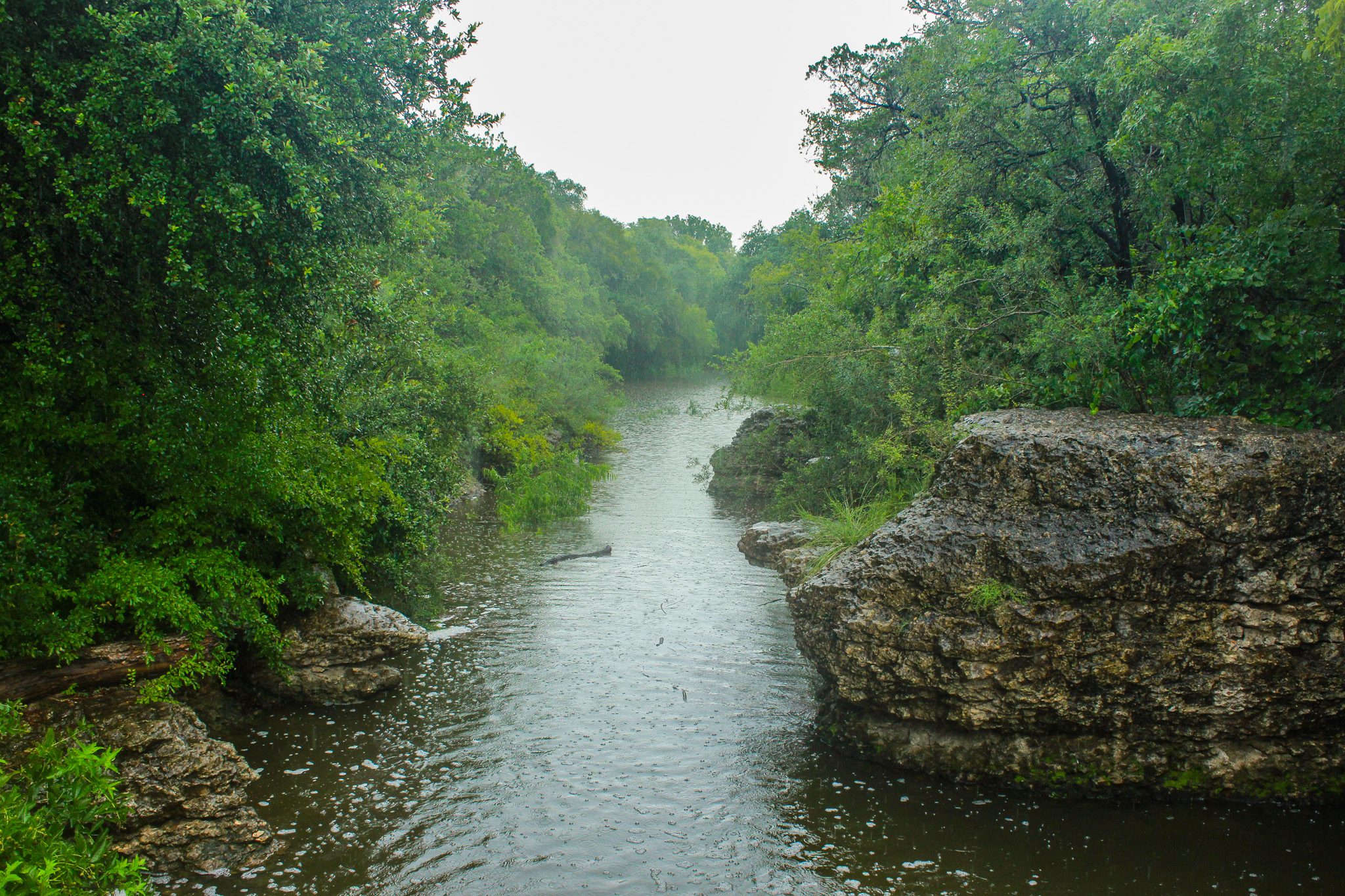Photo of Bear Creek amongst rainfall in July 2024.
After last year’s brutally hot and dry summer, this season has come as a welcome reprieve. During July 2024 Camp Mabry saw 10 triple digit days with an average high of 96° as compared July 2023’s 25 triple digit days and an average high of 103°. Even though the Hill Country missed out on major precipitation from Hurricane Beryl, the fourth week of July brought above average rains and cooler temperatures with highs ranging from the low 80’s to low 90’s. The low pressure that caused the span of cooler, wetter weather has now been replaced with ridge of high pressure AKA a “heat dome”, and the area is facing what could be its hottest week of 2024.

Rainfall
July is typically the region’s driest month of the year with an average of 2.1 inches of rain. This July, the District received an average of 5.3 inches. We’re experiencing 2.4 inches of surplus rainfall for 2024 but remain at a 14-inch rain deficit over the last 24 months.

Barton Springs Flow
As of August 6, Barton Springs maintains a 10-day average flow of 37 cubic feet per second (cfs), keeping it within Stage II Alarm Drought status (figure 2). Summer typically sees declining spring flow due to reduced rainfall, increased groundwater usage, and higher evaporation rates. While July’s above-average rainfall hasn’t substantially boosted spring flow, it has stabilized or slowed the usual seasonal decline. Since early June, flows have held steady in the high to mid-30 cfs range.

Lovelady Monitor Well
On August 6, the Lovelady well’s 10-day average water level measures 466.7 feet above mean sea level (ft-msl), approximately 4 feet higher than the Stage III Critical Drought threshold (figure 3). Throughout June, Lovelady’s water levels closely mirrored the stable patterns seen at Barton Springs. However, July saw a downward trend. Just as we witnessed a delayed positive response in water levels following May’s rainfall, we could observe another increase or stabilization at Lovelady in response to July rainfall in August.

Upper and Middle Trinity
The Upper Trinity Aquifer (green) saw substantial water level increases during late June rain events and has since stabilized (figure 4). In contrast, the Middle Trinity Aquifer (purple) has displayed a more modest holding pattern since late March, with only a slight decline beginning in late April and persisting through July.

Jacob’s Well Spring (JWS) reported a maximum discharge of 4 cubic feet per second (cfs) during late July rain events and has sustained flows at or slightly above 1 cfs since July 25. Concurrently, the Blanco River at Wimberley gauge recorded two distinct discharge peaks in late July, with a maximum of 40 cfs on July 23. As of August 6, the Blanco River’s discharge fluctuates between 6 and 8 cfs.

Highland Lakes
In July Lake Buchanan’s levels decreased from 73% to 70%. Lake Travis, on the other hand, increased from 42% to 49%, rose by 6 feet, and is higher now than it was at any point in 2023. This increase was a result of LCRA opening floodgates at Max Starcke Dam in Marble Falls, sending millions of gallons of water per minute downstream to Lake Travis. Combined, the lakes Buchanan and Travis are sitting at 58%, which is 2% higher than last month.
Aquifer Status and Forecast
Despite the welcome occurrence of above-average precipitation within our District last month, a substantially greater volume of rainfall is required to replenish groundwater levels and reinvigorate spring flow rates, particularly for springs sourced from the Trinity Aquifer, like Jacob’s well and Pleasant Valley Springs.. The recharge zones for the Trinity Aquifer are primarily located in the Hill Country region, encompassing sections of Blanco, Hays, Comal, and Travis counties. These zones are characterized by surface exposures of Trinity Group rocks, generally situated west of Austin.
NOAA’s Seasonal Temperature Outlook for August, September, and October predicts above average temperatures for the vast majority of the lower 48. Central Texas has equal chances for above and below average rainfall during this timeframe. Conditions have shifted from El Niño to neutral and La Niña is expected to develop between now and October. La Niña tends to result in wetter, cooler conditions in the northern US and drier and warmer conditions in the south.
Conservation
Eager to save the maximum amount of water possible? Then let your lawn go “summer blond” this season. By not watering your lawn from August to September, you could reduce your water consumption by thousands of gallons. When established lawns turn brown, they’re oftentimes simply going dormant in response to high temperatures and low water. It’s grass’ way to conserve water and energy. Most grasses will green up again once the temperatures declines and rains return.
Remember, every gallon of water used on your lawn is one less gallon in the Texas Hill Country’s beloved creeks, lakes, rivers, and swimming holes. It’s also one less gallon of drinking water available to our community while we continue to weather this multi-year drought.

